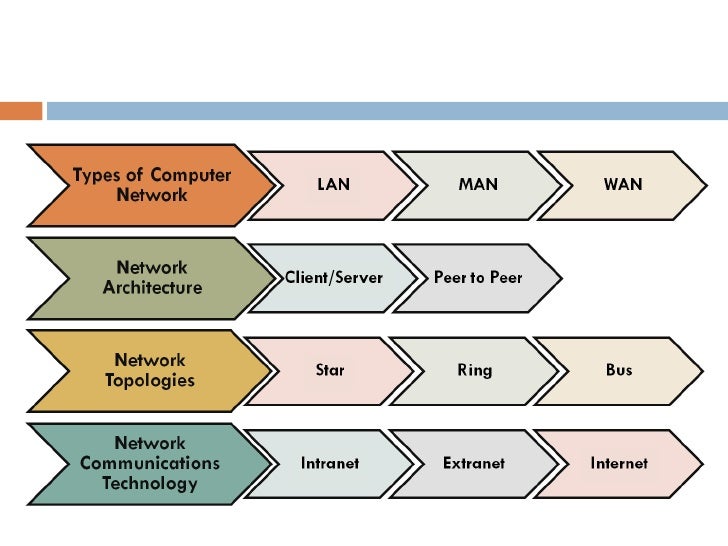Basics of Network

Network:
When you have two or more computers connected
to each other, you have a network. The purpose of a network is to enable the
sharing of files and information between multiple systems. The Internet could
be described as a global network of networks. Computer networks can be
connected through cables, such as Ethernet cables or phone lines, or
wirelessly, using wireless networking cards that send and receive data through
the air.
Types
of Network:
• LAN - Local Area Network
• WLAN - Wireless Local Area Network
• WAN - Wide Area Network
• MAN - Metropolitan Area Network
• SAN - Storage Area Network, System
Area Network, Server Area Network, or sometimes Small Area Network
• CAN - Campus Area Network, Controller
Area Network, or sometimes Cluster Area Network
• PAN - Personal Area Network
• DAN - Desk Area Network
LAN and WAN were the
original categories of area networks, while the others have gradually emerged
over many years of technology evolution.
LAN - Local Area Network
A LAN connects network
devices over a relatively short distance. A networked office building, school,
or home usually contains a single LAN, though sometimes one building will
contain a few small LANs (perhaps one per room), and occasionally a LAN will
span a group of nearby buildings. In TCP/IP networking, a LAN is often but not
always implemented as a single IP subnet.
In addition to
operating in a limited space, LANs are also typically owned, controlled, and
managed by a single person or organization. They also tend to use certain connectivity
technologies, primarily Ethernet and Token Ring.
WAN - Wide Area Network
As the term implies, a
WAN spans a large physical distance. The Internet is the largest WAN, spanning
the Earth.
A WAN is a
geographically-dispersed collection of LANs. A network device called a router
connects LANs to a WAN. In IP networking, the router maintains both a LAN
address and a WAN address.
A WAN differs from a
LAN in several important ways. Most WANs (like the Internet) are not owned by
any one organization but rather exist under collective or distributed ownership
and management.
LAN, WAN and Home Networking
Residences typically
employ one LAN and connect to the Internet WAN via an Internet Service Provider
(ISP) using a broadband modem. The ISP provides a WAN IP address to the modem,
and all of the computers on the home network use LAN (so-called private) IP
addresses. All computers on the home LAN can communicate directly with each
other but must go through a central gateway, typically a broadband router, to reach
the ISP.
Other Types of
Area Networks
While LAN and WAN are
by far the most popular network types mentioned, you may also commonly see
references to these others:
• Wireless Local Area Network - a LAN
based on WiFi wireless network technology
• Metropolitan Area Network - a network
spanning a physical area larger than a LAN but smaller than a WAN, such as a
city. A MAN is typically owned an operated by a single entity such as a
government body or large corporation.
• Campus Area Network - a network spanning
multiple LANs but smaller than a MAN, such as on a university or local business
campus.
• Storage Area Network - connects
servers to data storage devices through a technology like Fiber Channel.
• System Area Network - links
high-performance computers with high-speed connections in a cluster
configuration also known as Cluster Area Network.
Protocols:
A network
protocol defines rules and
conventions for communication between network devices. Protocols for computer
networking all generally use packet
switching techniques to send and receive messages in the form of packets.
Network protocols include mechanisms for devices
to identify and make connections with each other, as well as formatting rules
that specify how data is packaged into messages sent and received. Some
protocols also support message acknowledgement and data compression designed
for reliable and/or high-performance network communication. Hundreds of
different computer network protocols have been developed each designed for
specific purposes and environments.
Internet Protocols
The Internet Protocol family contains a set of
related (and among the most widely used network protocols. Besides Internet Protocol (IP) itself, higher-level protocols like TCP, UDP, HTTP, and FTP all integrate with IP to provide
additional capabilities. Similarly, lower-level Internet Protocols like ARP and ICMP also co-exist with IP. These
higher level protocols interact more closely with applications like Web
browsers while lower-level protocols interact with network adapters and other
computer hardware.
Routing Protocols
Routing protocols are designed specifically for
use by network routers on the Internet. Common routing
protocols include EIGRP, OSPF and BGP.
Some
Basic Protocols:
- ARP: Address
Resolution Protocol
The address resolution protocol (ARP) is a protocol used by the Internet
Protocol (IP), to map IP network addresses to the hardware addresses used by a data link protocol. The
protocol operates below the network layer as a part of the interface between
the OSI network and OSI link layer. It is used when IPv4 is used over Ethernet.
- IP: Internet Protocol Address
An Internet Protocol is a set of rules which
govern Internet activity and facilitate completion of a variety of actions on
the (www) World Wide Web.
.


